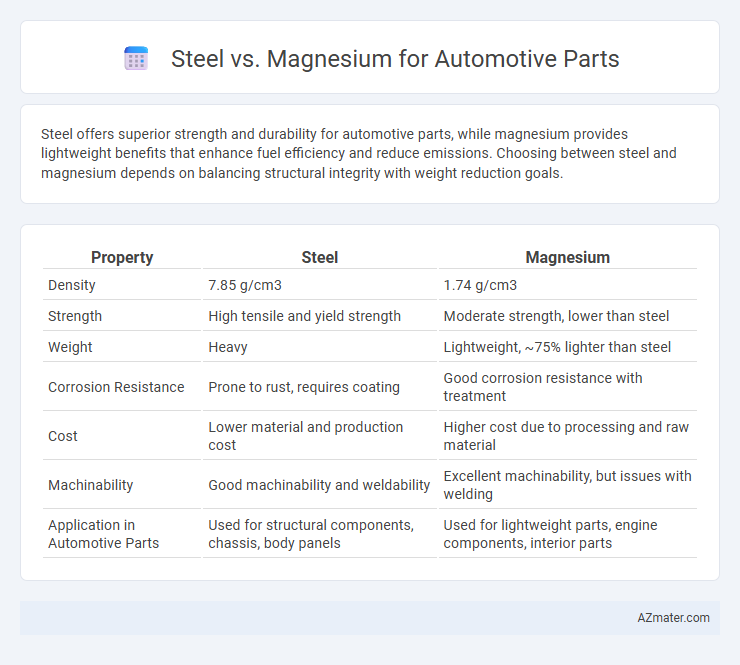Steel offers superior strength and durability for automotive parts, while magnesium provides lightweight benefits that enhance fuel efficiency and reduce emissions. Choosing between steel and magnesium depends on balancing structural integrity with weight reduction goals.
Table of Comparison
| Property | Steel | Magnesium |
|---|---|---|
| Density | 7.85 g/cm3 | 1.74 g/cm3 |
| Strength | High tensile and yield strength | Moderate strength, lower than steel |
| Weight | Heavy | Lightweight, ~75% lighter than steel |
| Corrosion Resistance | Prone to rust, requires coating | Good corrosion resistance with treatment |
| Cost | Lower material and production cost | Higher cost due to processing and raw material |
| Machinability | Good machinability and weldability | Excellent machinability, but issues with welding |
| Application in Automotive Parts | Used for structural components, chassis, body panels | Used for lightweight parts, engine components, interior parts |
Introduction to Steel and Magnesium in Automotive Parts
Steel remains a dominant material in automotive parts due to its high tensile strength, durability, and cost-effectiveness, supporting structural components and safety features. Magnesium is gaining traction in the industry for its lightweight properties, offering significant weight reduction and improved fuel efficiency without compromising performance. Both materials play critical roles in automotive design, balancing strength, weight, and cost considerations to meet evolving regulatory and consumer demands.
Material Properties: Steel vs Magnesium
Steel offers superior tensile strength and durability compared to magnesium, making it ideal for structural automotive components requiring high load-bearing capacity. Magnesium provides significant weight reduction, with a density approximately 75% less than steel, enhancing fuel efficiency and vehicle handling. Corrosion resistance in magnesium alloys varies widely and often necessitates protective coatings, while steel benefits from well-established corrosion prevention techniques such as galvanization.
Weight Comparison and Impact on Vehicle Performance
Magnesium automotive parts weigh up to 35% less than comparable steel components, significantly reducing overall vehicle mass and improving fuel efficiency. The lower density of magnesium enhances acceleration, braking, and handling due to decreased unsprung weight, contributing to better vehicle dynamics. However, steel offers superior strength and durability, which can influence crashworthiness and long-term performance despite its heavier weight.
Strength and Durability Considerations
Steel offers superior tensile strength and impact resistance, making it ideal for high-stress automotive parts requiring long-term durability. Magnesium is significantly lighter, which improves fuel efficiency but has a lower strength-to-weight ratio and is more prone to corrosion and fatigue over time. Balancing weight reduction with mechanical performance is critical when choosing between steel and magnesium for structural automotive components.
Corrosion Resistance: Which Material Prevails?
Magnesium offers lightweight advantages but is more susceptible to corrosion compared to steel, which typically exhibits superior corrosion resistance due to protective oxide layers and the availability of various coatings like galvanization. Steel's durability in corrosive environments is enhanced by advanced treatments such as zinc plating and powder coating that significantly extend part lifespan. Despite magnesium's potential for corrosion with exposure to moisture and salts, modern alloys and protective coatings are improving its resistance, yet steel remains the predominant choice for automotive parts requiring robust corrosion protection.
Cost Analysis: Steel vs Magnesium
Steel remains more cost-effective for automotive parts due to its lower raw material and manufacturing costs, despite being heavier. Magnesium offers weight reduction benefits that can improve fuel efficiency, but its higher material price and specialized processing increase overall production expenses. Cost analysis favors steel for budget-conscious manufacturers, while magnesium suits applications prioritizing lightweight design and performance.
Manufacturing Processes and Feasibility
Steel offers superior strength and durability, making it suitable for automotive parts requiring high load-bearing capacity, and its well-established manufacturing processes include stamping, welding, and machining, ensuring cost-effective mass production. Magnesium, being significantly lighter, enhances fuel efficiency and performance but demands specialized manufacturing techniques such as die casting and precision machining due to its lower melting point and flammability concerns. Feasibility considerations favor steel for large-scale production due to its cost-effectiveness and material availability, whereas magnesium is preferred for lightweight, high-performance applications despite higher processing complexity and expense.
Environmental Impact and Sustainability
Steel offers high recyclability and durability, making it a sustainable choice for automotive parts due to its widespread recycling infrastructure and energy-efficient steel production technologies. Magnesium, significantly lighter than steel, reduces vehicle weight and enhances fuel efficiency, lowering emissions during the vehicle's operational life, but its extraction and processing have higher environmental costs and lower recycling rates. Balancing the environmental impact, steel remains favorable for long-term sustainability, while magnesium provides ecological benefits primarily through improved fuel economy and emission reductions.
Application Examples in Modern Vehicles
Steel is extensively used in automotive parts such as chassis, body panels, and safety cages due to its high strength, durability, and cost-effectiveness. Magnesium alloys are increasingly applied in engine blocks, transmission cases, and interior components to reduce vehicle weight and improve fuel efficiency while maintaining adequate strength. Modern vehicles leverage steel for structural integrity and magnesium for lightweight applications, combining both metals to optimize performance and sustainability.
Future Trends and Innovations in Automotive Materials
The automotive industry is increasingly adopting magnesium alloys due to their superior strength-to-weight ratio and potential for significant fuel efficiency improvements compared to traditional steel parts. Innovations in alloy composition and advanced manufacturing techniques, such as additive manufacturing and high-pressure die casting, are enhancing magnesium's durability and corrosion resistance, making it a viable alternative for structural components. As electric vehicle production rises, magnesium's contributions to weight reduction are critical for extending battery range and improving overall vehicle performance, signaling a shift toward lightweight, high-performance materials.

Infographic: Steel vs Magnesium for Automotive Part
 azmater.com
azmater.com